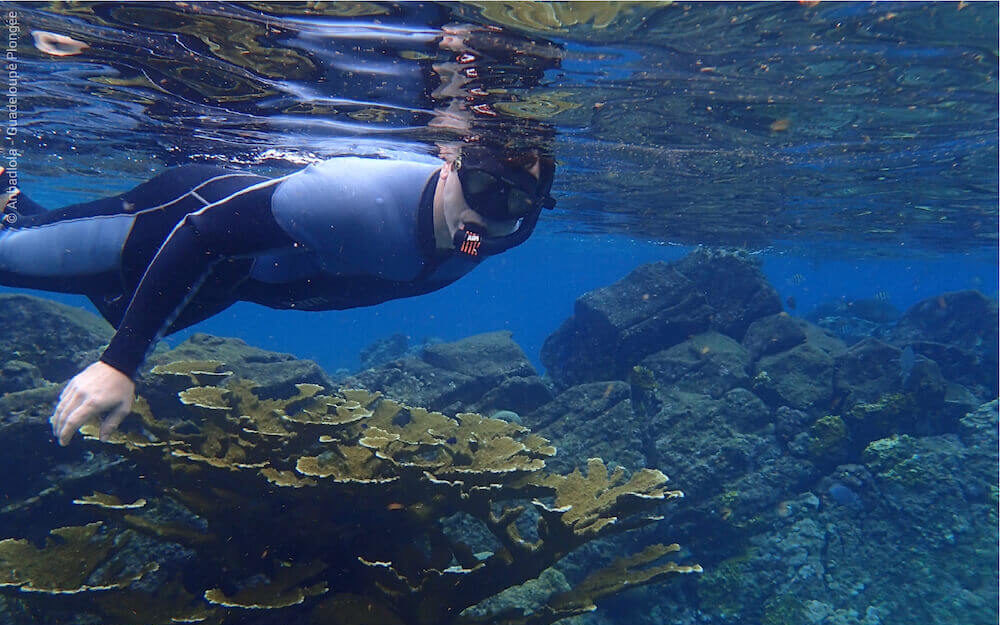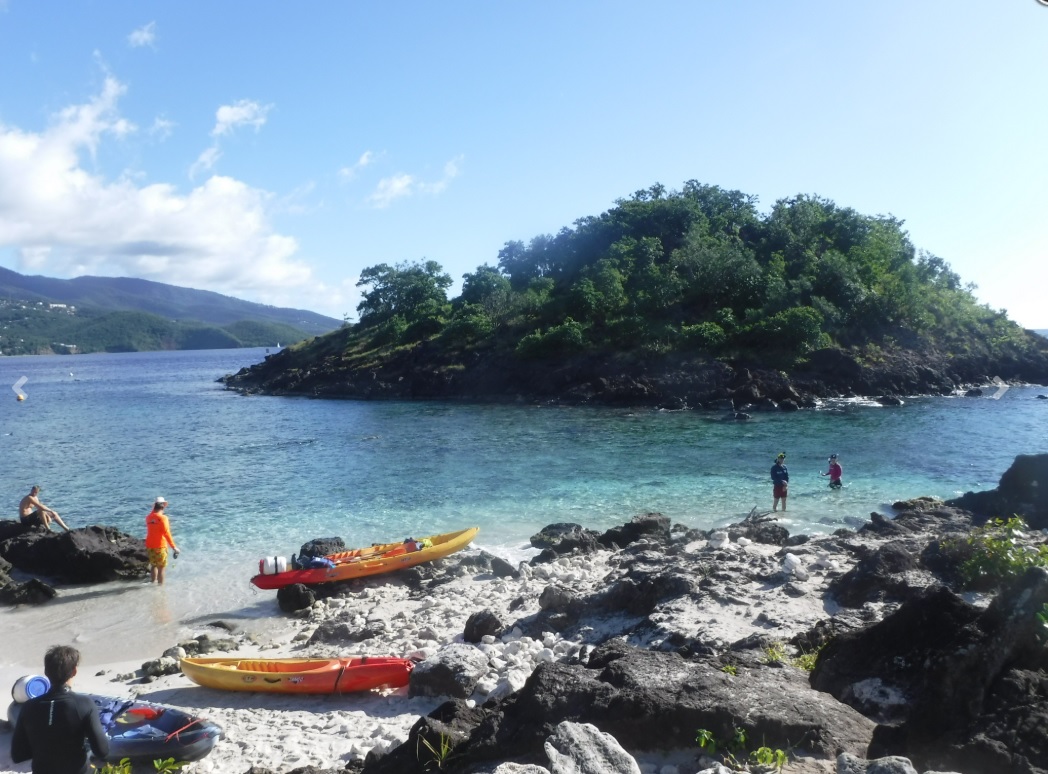Case Study
Good behaviour in the marine environment: Guadeloupe National Park
Contact name
Xavier Delloue, Chef - Pôle Milieux Marins
Institution name
Guadeloupe National Park
Region & country
Guadeloupe, France
Summary
The main mission of the Guadeloupe National Park is to preserve the marine and terrestrial ecosystems located on its territory.
The respect of the regulations and the adoption of good behaviour are the necessary conditions for the sustainable and shared exercise of any activity developed in this protected natural space.
This guide to good behaviour, drawn up and signed by the National Park and its partners, is intended for all users of the marine areas of the National Park.


Background of the project
It could be perceived that outdoor sports in the marine environment do not produce such a disturbing effect on the biodiversity present in the water, either because of the enormous size of the seas and oceans or because of the lesser direct contact with the land (in this case the seabed). However, this is not entirely true, as the development and promotion of many aquatic activities has highlighted a clear increase in pressure on marine areas, which are among those most affected by climate change, especially near the tropics, as is the case in Guadeloupe. This conditions an inevitable impact on species not only under water but also on the surface, such as birds. In addition, in order to carry out some activities such as diving, the transport is done in boats that produce noise, pollute and can destroy the sea bed with their mooring systems.
Given this situation, it is necessary to communicate and demand responsible and respectful behaviour towards the marine environment, especially on the part of those professional operators who use the protected area to offer their services and develop their activities.
Solution and actions taken
What solution you found to cover those needs?
The first solution was to establish a system of authorizations by the park for those actors who carry out a professional activity in the park, signing agreements as partners through which they commit to respect the park’s instructions regarding the areas where to operate, as well as rules of behavior that must be integrated and understood. In order to do this, a benchmarking campaign has been developed, selecting the most suitable operators to work in the area.
What actions did you take to reach the solution?
The first measure is the establishment of a guide of good behavior, which, in addition to being addressed to the general public, is an obligation for partners who have an authorization to operate in the Marine Protected Area.
This set of rules covers a diverse number of sporting activities, with a strong focus on respect for biodiversity.
This is the content of the guide:
Eco-responsible behaviour
– bring back my garbage and other people’s garbage
– do not make a fire on the ground
– be quiet
– do not use disposable cutlery
– do not discharge washing and food water
– do not empty grey and black water tanks
– do not feed or disturb the animals
– do not take or manipulate the flora
– respect the whale-watching charter
– do not carry out maintenance work of the vessel at sea
Behaviours related to navigation and anchoring
– have a clean, well-trimmed and serviceable vessel
– limiting greenhouse gas emissions and noise and odour pollution as much as possible
– reduce the speed to 5 knots within 300m of the coastline and mangroves
– use the anchorages
– around the islets (except Pigeon islets), moor the boats (after disembarking passengers) more than 10 meters from the shore (swimming area)
– use anchors only on sandy or muddy areas, anchor and chain outside of meadows – under no circumstances should the mooring line be used in areas of sea grass or coral formations –
– do not shift the anchor but raise it vertically
– do not sail in shallow areas where the propellers may damage the seabed
Snorkeling, diving and swimming activities
– do not to touch the fauna and flora
– do not have contact with turtles
– do not to take live or dead animals or plants (e.g. shellfish)
– stay away from bird nests and resting places
– avoid contact with the bottom outside sandy areas
– make a very moderate use of flash and Led lighting and avoid flashing the eyes of animals
– avoid repeated and prolonged passages under overhangs and in caves
– pick up any rubbish discovered
Kayak and sea biking activities
– gather the boats on the beach so as not to clutter up the space.
– keep a reasonable distance from the birds so as not to disturb them
Bird Discovery Activities
– approaching bird resting places and colonies obliquely to the shore at very slow speed and without noise
– limit the approach distance to 50 m
– avoid parking for too long (no more than 10 minutes).
– circulate silently or quietly on the edge of the mangrove swamps
– report any special observations to the national park :
◦ unusual, rare or uncommon bird
◦ banded or tagged bird
◦ special behaviour
◦ endangered or distressed bird
This activity, which may seem insignificant, is not without consequences on the installation of the breeding couples or the success of their broods, some species do not tolerate well the disturbances. Untimely or repeated disturbances may discourage some birds from returning to nest on the site the following season. They can also have a direct impact on the survival of eggs or chicks that, without parental protection, are vulnerable to predators and sunstroke. On the resting places, regular disturbance of the birds imposes on them an unnecessary expenditure of energy damaging their metabolism, just as it can disturb the preparation of their plumage (drying, oiling…) essential to their survival.
Landing on the islets
– check that there are no “stowaway” animals on board (rats, lizards, young iguanas, frogs, mice, etc.)
– check the passengers’ bags
– Avoid beaching; if it is essential for the time being, do it only in areas of bare sand
– avoid trampling on vegetation
– limit the walking approach distance to 150 m from resting places and bird colonies
Other institutions or parties involved
- Tourism service providers
- The National Park’s scientific committee
Results
The results are difficult to analyse as variations in the levels of biodiversity are largely due to other aspects such as the alteration in the chemical conditions of water, produced by agricultural waste and other productive activities of human origin. This makes it difficult to establish a sufficiently clear cause-effect relationship, so that no significant results can be affirmed at present.
Challenges
One of the problems is the possibility of extending the licensing and control system to the general public. There is a great difficulty in making understand those actors, who were already present in the area before the establishment of the natural park, the importance of respectful practices.
This is precisely the challenge that is now being posed, for which the park has already begun to take the necessary actions to develop a transversal project that includes a complete action plan around sports activities. One of the aspects around which this project is intended to revolve are the schemes for reinvesting funds to finance the restoration of marine spaces.
Lessons learned
The main lesson learned throughout the development of the activities is the need to convince everyone of the necessary integration of good behaviour, as well as to make the actors involved endorse it and work with it on a daily basis.
Contact name
Xavier Delloue, Chef - Pôle Milieux Marins
Institution name
Guadeloupe National Park
Website(s)
